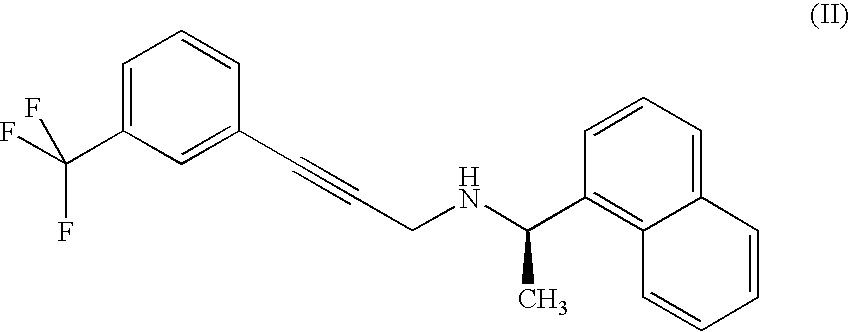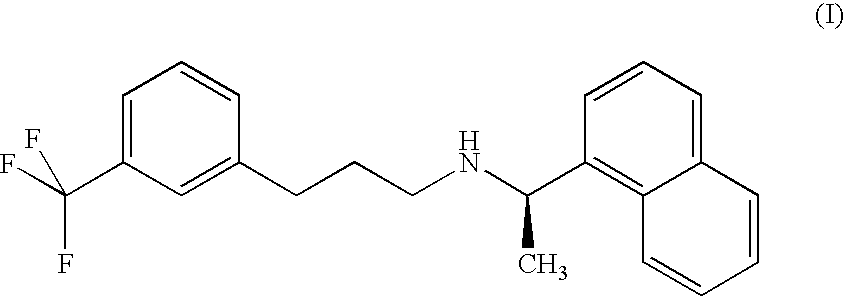Process for the preparation of cinacalcet
a technology of cinacalcet and process, which is applied in the preparation of organic compounds, amino compounds, organic chemistry, etc., can solve the problems of affecting costs and production times, remarkably, and subsequent remarkable increases in costs
- Summary
- Abstract
- Description
- Claims
- Application Information
AI Technical Summary
Benefits of technology
Problems solved by technology
Method used
Image
Examples
example 1
Synthesis of Compound (IV)
1-(3-Hydroxy-prop-1-inyl)-3-trifluoromethyl-benzene
[0045]50 g of 3-bromo benzotrifluoride (0.22 mole, 31 ml) are dissolved in 75 ml of triethylamine and 25 ml of dimethylacetamide under nitrogen atmosphere. The mixture is heated to 50° C., then 340 mg (1.76 mmoles) of copper (I) iodide, 155 mg (0.88 mmoles) of palladium (II) chloride and 930 mg (3.55 mmoles) of triphenylphosphine are added. The mixture is adjusted to 70° C. and 16 ml (16 g, 0.29 moles) of propargyl alcohol are slowly dropped therein. After 17 hours, the reaction mixture is diluted with toluene and filtered. The filtrate is washed in succession with a 1N HCl aqueous solution, saturated NaHCO3 and water. The organic phase is then dried over dry Na2SO4, and filtered. The solvent is evaporated off under reduced pressure to yield compound (IV).
[0046]1H NMR (300 MHz, DMSO-d6), ppm: 7.72-7.69 (m, 3H), 7.60 (t, 1H, J 7, 5 Hz), 5.38 (t, 1H, J 6.0 Hz), 4.31 (d, 2H, J 6.0 Hz).
example 2
Synthesis of a Compound (III)
1-(3-Methanesulfonyloxy-prop-1-inyl)-3-trifluoromethyl-benzene
[0047]44 g of compound of formula (IV) (0.22 moles) and 36.8 ml of triethylamine are dissolved in 195 ml of toluene. The mixture is cooled in an ice bath and a solution of methanesulfonyl chloride (18.7 ml, 0.24 moles) in toluene (30 ml) is slowly dropped therein. After completion of the addition, the mixture is brought again at room temperature and filtered. The solution is washed with a NaHCO3 saturated solution, dried over dry Na2SO4 and filtered. The solvent is evaporated under reduced pressure to yield the compound III.
[0048]1H NMR (300 MHz, DMSO-d6), ppm: 7.84-7.74 (m, 3H), 7.64 (t, 1H, J 7.8 Hz), 5.21 (s, 2H), 3.28 (s, 3H).
example 3
Synthesis of Compound of Formula (II) Hydrochloride
(1-Naphthalen-1-yl-ethyl)-[3-(3-trifluoromethyl-phenyl)-prop-2-inyl]-amine
[0049]5.9 ml (6.2 g, 0.036 mmoles) of (R)-1-(1-naphthyl)ethylamine are dissolved in acetonitrile (30 ml). Then 4.97 g (0.036 mmoles) of K2CO3 and a solution of compound of formula (III) (10.1 g, 0.036 mmoles) in acetonitrile (15 ml) are added. The reaction mixture is heated to 50° C. and kept under stirring for 17 hours, then concentrated under reduced pressure. The residue is diluted in toluene and filtered. The solution is heated to 50° C. and treated with 1M HCl. The suspension is filtered and the resulting precipitate is crystallized from a toluene / methanol solution. The hydrochloride of compound of formula (II) is then dried, and it has purity higher than 99.5%.
[0050]1H NMR (300 MHz, DMSO-d6), ppm: 8.32 (d, 1H, J 9.0 Hz), 8.05-7.96 (m, 3H), 7.80-7.50 (m, 7H), 5.53 (q, 1H, J 6.6 Hz), 4.15, 4.00 (system AB, 2H, J 17.1 Hz), 1.73 (d, 2H, J 6.6 Hz).
PUM
| Property | Measurement | Unit |
|---|---|---|
| pressure | aaaaa | aaaaa |
| pressure | aaaaa | aaaaa |
| atmospheric pressure | aaaaa | aaaaa |
Abstract
Description
Claims
Application Information
 Login to View More
Login to View More - R&D
- Intellectual Property
- Life Sciences
- Materials
- Tech Scout
- Unparalleled Data Quality
- Higher Quality Content
- 60% Fewer Hallucinations
Browse by: Latest US Patents, China's latest patents, Technical Efficacy Thesaurus, Application Domain, Technology Topic, Popular Technical Reports.
© 2025 PatSnap. All rights reserved.Legal|Privacy policy|Modern Slavery Act Transparency Statement|Sitemap|About US| Contact US: help@patsnap.com



